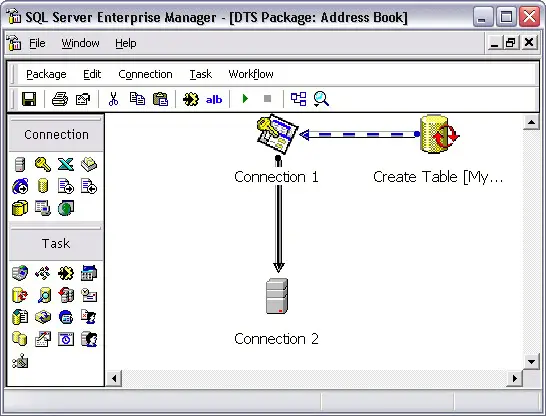Table of Contents
Today I had to update a certain number of old Windows Server 2003 and Windows XP virtual machines to their Windows Server 2016 and Windows 10 up-to-date counterparts. Among the various things I had to do to update their software packages, the hardest issue was to make the Data Transformation Services (DTS) Designer components work with with a not-so-terrible version of SQL Server Management Studio, such as SSMS 2008 - which you can still download from this MS official link.
For those who don't know it, the DTS Designer components is a software package which allows developers to work with the Data Transformation Services objects with a visual GUI: such tool was quite popular in early 2000's, from SQL Server 7 to SQL Server 2000 and it basically allowed data to be transformed and loaded from heterogeneous sources using OLE DB, ODBC, or text-only files, into any supported database (MS Access, SQL Server, Microsoft Jet and so on).
One of the most interesting features of DTS was its Designer component, which used to run within SQL Enterprise Manager - the "old" SQL Management Studio - as an external module.
Unfortunately for it, DTS has been discontinued few years after its release - being superseded by SQL Server Integration Services starting from SQL Server 2005: an umpredictable turn of events that wasn't so great for those developers who used to work with it.
To ease the transition, Microsoft did ensure some backwards compatibility with the release of some packages that basically ensured full DTS support - including the Designer component - in SQL Server Management Studio 2005.
SQL Server Management Studio 2005
That said, if you have SSMS 2005 installed, all you need to do to make DTS work is to download and install the following packages from these components:
- Microsoft SQL Server 2000 DTS Designer Components - package name: SQLServer2005_DTS.msi
- SQL Server 2005 Backward Compatibility Components - package name: SQLServer2005_BC.msi
Be sure to download the proper executable for your system's architecture: if you have a x64 machine and get a x86 package, you'll end up with the following error:
Installation of this product failed because it is not supported on this operating system. For information on supported configurations, see the product documentation.
Once installed, check out the following folders:
|
1 2 |
C:\Program Files (x86)\Microsoft SQL Server\80\Tools\Binn \ C:\Program Files\Microsoft SQL Server\80\Tools\Binn\ |
Ensure that they have been created and that they contain a decent amount of DLL files: if they do, keep going, otherwise you'll need to reinstall SSMS and start over again (be sure to do a full / complete installation this time).
The last thing you need to do to get the job done is to manually edit your system PATH environment variable (Control Panel > System > Advanced > Evironment Variables) and ensure that both the following conditions are true:
- The PATH environment variable contains the two folders described above.
- Both ot them are mentioned before any other path containing "Microsoft SQL Server".
If everything is true, you should be good to go: reboot your machine, launch SSMS 2005 and check out if the DTS Designer is working properly as it should. In case it doesn't, check out the Troubleshooting paragraph below for a brief list of common issues & fixes.
SQL Server Management Studio 2008
If you want to install the DTS backward-compatibility support in SSMS 2008, SSMS 2008R2 or greater, you must still follow all the required steps for SSMS 2005 described above, plus the following ones:
32-bit Windows Server (x86)
- Navigate through the %ProgramFiles%\Microsoft SQL Server\80\Tools\Binn\ folder.
- Select & copy (CTRL+C) the following files: SEMSFC.DLL, SQLGUI.DLL, SQLSVC.DLL
- Paste those files within the %ProgramFiles%\Microsoft SQL Server\100\Tools\Binn\VSShell\Common7\IDE\ folder.
- Navigate through the %ProgramFiles%\Microsoft SQL Server\80\Tools\Binn\Resources\ folder.
- Select & copy (CTRL+C) the following files: SEMSFC.RLL, SQLGUI.RLL, SQLSVC.RLL
- Paste those same files within the %ProgramFiles%\Microsoft SQL Server\100\Tools\Binn\VSShell\Common7\IDE\Resources\NNNN\ folder, where NNNN is the number of your Operating System's locale (for example, 1033 for English): for a list of all available LCIDs, check out this post.
- Reboot your system.
On a system with default installation settings, %ProgramFiles% points to C:\Program Files.
64-bit Windows Server (x64)
On a 64-bit machine the job to be done is the same as above, replacing %ProgramFiles% with %ProgramFiles(x86)%.
On a system with default installation settings, %ProgramFiles(x86)% points to C:\Program Files (x86).
Troubleshooting
Here's a list of possible error messages that you might get while testing the above workaround and their possible fixes.
SQL Server 2000 DTS Designer components are required
This nasty error does not occur on all systems: as of today, I've only seen on two Windows Server 2003 and Windows Server 2012 R2 machines; nonetheless, it was a real deal to overcome.
Here's the full error message:
SQL Server 2000 DTS Designer components are required to edit DTS packages. Install the special Web download, "SQL Server 2000 DTS Designer Components" to use this feature. (Microsoft.SqlServer.DtsObjectExplorerUI)
And here's what you need to do to overcome it:
- Go to the %Program Files(x86)%\Microsoft SQL Server\80\Tools\Binn folder.
- Make a copy of the stardds.DLL file (if present), or just rename it to stardds.DLL.bak to keep it safe.
- If you're using Windows Server 2003 or Windows Server 2003 R2, replace that file with this stardds.dll file (version 2000.80.2282.0).
- If you're using Windows Server 2008 or above, replace that file with this stardds.dll file (version 2000.90.4035.0) instead.
- Reboot your system and see if the "SQL Server 2000 DTS Designer components are required" issue has been fixed.
Conclusions
That's it for now: I hope that this tutorial will help those System Administrators that are struggling to make the DTS Designer component work in their SQL Server Management Studio environment.


